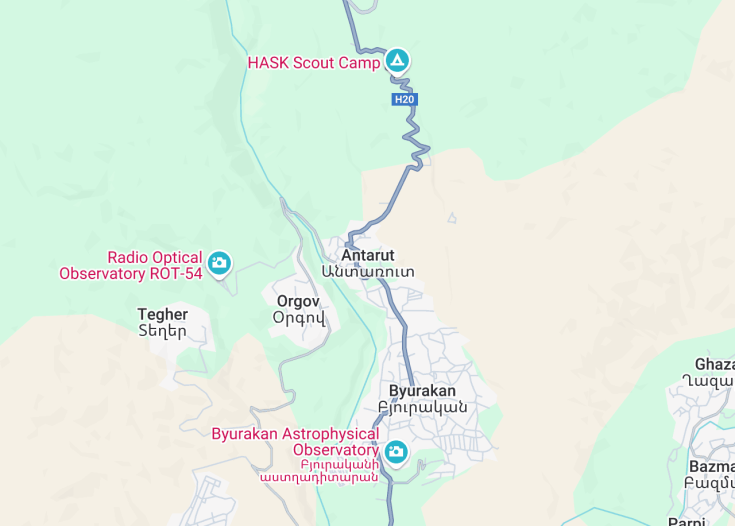Antarut, nestled in the picturesque terrain of Armenia, embodies a serene village escape, rich in cultural heritage and natural beauty. This destination is ideal for those seeking tranquility away from the bustling city life. Visitors to Antarut can explore ancient historical sites and enjoy the soothing landscapes that define this unique region. The village also serves as a gateway to understanding the traditional Armenian rural lifestyle, offering insights into the local customs and practices that have been preserved over centuries. With its scenic backdrops and a deeply rooted cultural tapestry, Antarut promises a genuine and enriching experience for all travelers.
Travel to Antarut during the spring or autumn months to experience the village’s natural landscape in full bloom or during the vivid fall colors.
Engage with the local community to enhance your visit. Participating in a village walk or a traditional cooking class can provide deeper insight into Antarut’s culture.
Antarut: Gateway to Ancient Traditions
| Country | Armenia |
| Time in Antarut | GMT+4 |
| Language spoken | Armenian |
| Population | 5,600 (City Population Data, 2023) |
| Currency | Armenian Dram (դր, AMD) |
| Airports |
|
Antarut, nestled in the heart of Armenia, boasts a rich heritage that mirrors the country’s complex historical tapestry. Known for its picturesque scenery and archaeological significance, Antarut stands as a cherished site where ancient Armenian culture continues to resonate. Visitors often remark on the village’s rustic charm and the welcoming nature of its residents. A hub for artisanal crafts and traditional Armenian architecture, Antarut is a place where the past comes alive. It serves not only as a cultural enclave but also as a point of connection to the various epochs of Armenian history. From ancient churches to vibrant local festivities, Antarut offers a profound glimpse into the spirit and resilience of Armenian heritage.
Where is Antarut?
Nestled in the Armenian highlands, Antarut is surrounded by mountains, providing it with picturesque landscapes and a serene environment.
Distances:
| Route | Distance by car | Time by car |
|---|---|---|
| Yerevan to Antarut | 51 miles (82 km) | 1 hour 20 minutes |
| Gyumri to Antarut | 75 miles (121 km) | 1 hour 45 minutes |
What is Antarut famous for?
Antarut is famed for its historical ruins and lush vineyards, offering a unique blend of natural beauty and historical intrigue that captivates tourists and historians alike.
History
Antarut, a storied village nestled in the heart of Armenia, boasts a rich tapestry of history that traces back to antiquity. The region has witnessed numerous historical transformations, each contributing layers to its intriguing past.
Pre-Medieval Era (Before 4th Century AD)
The earliest record of human activity in the Antarut area dates back to pre-Christian times when it was primarily inhabited by pagan tribes. These early inhabitants held profound respect for nature, which is evident from the remnants of their ritual sites found around the village.
Medieval Armenia (4th Century – 15th Century)
With the advent of Christianity as Armenia’s state religion in the early 4th century, Antarut began to evolve significantly. The construction of the first church marked a pivotal transformation in the village’s character, weaving it more tightly into the fabric of Ararat Province. During this period, the village was often caught in the crossfire of various regional powers, including the Byzantines, Persians, and later, the Turkish empires, each shaping its cultural and architectural heritage.
Under Ottoman and Persian Rule (16th Century – 19th Century)
The geopolitical importance of Antarut waxed and waned under the oscillating control of Ottoman and Persian empires. The community cultivated a resilient socio-economic structure, maintaining their unique cultural practices and the Armenian language despite the external influences and periodic religious imposition.
Modern Era (20th Century – Present)
In the tumult of the 20th century, particularly during the Armenian Genocide and the subsequent Soviet period, Antarut’s residents faced significant hardships. Post-Soviet era brought with it new challenges and opportunities. Since Armenia’s independence in 1991, Antarut has been part of the newly sovereign nation, experiencing modest development while striving to preserve its historical identity amidst the evolving contemporary panorama.
Visit Antarut
What to see and do in Antarut, Armenia
Antarut is a hidden gem awaiting discovery, where visitors can immerse themselves in a blend of historical allure and natural beauty. Noteworthy attractions include:
- The ancient church at the center of the village, which stands as a testament to the region’s enduring Christian heritage.
- Scenic walking trails that meander through lush landscapes, offering panoramic views of the surrounding Ararat plain.
- Traditional stone houses that illustrate classic Armenian architectural styles, providing a glimpse into the rural life of yesteryears.
Annual Festivals in Antarut
The village of Antarut is vibrant with cultural festivities, particularly notable for its annual harvest festival, which takes place in the autumn. This event celebrates the agricultural bounty of the region, featuring local music, dance, and food, providing a profound insight into the community’s traditions and lifestyles.
Best time to visit Antarut
The most favorable time to visit Antarut is during the spring (April to June) or early autumn (September and October), when the weather is mild, and the natural landscape is at its most vibrant.
Is Antarut worth visiting?
Antarut is undoubtedly worth a visit for those who cherish historical depth and cultural authenticity. It offers a peaceful retreat from the modern world, allowing visitors to connect with the enduring spirit of Armenia through its ancient ruins, pastoral landscapes, and the warm hospitality of its residents. Antarut presents a unique opportunity to explore an undiscovered part of this historic region.









